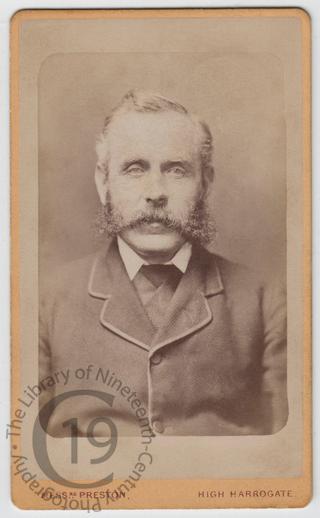
William Lewis George
A carte-de-visite portrait of a sitter identified verso as William Lewis George. The full inscription reads:
‘Wm Lewis George Sentenced to 10 yrs / Penal Servitude & 5 years P. Supo. [police supervision]/ 20 August 1877 — Wkfld. [Wakefield] Sessions. ‘
An early report of his arrest appeared in the Wetherby News (19 July 1877) ‘EXTENSIVE ROBBERY AT HARROGATE — The police have in custody at Knaresborough a person named William Lewis George, on three charges of felony. The prisoner has for about a month been in lodgings at Mr Taylor’s, Beech Wood boarding house, Low Harrogate, and he is charged with stealing £28 in notes and gold from two other lodgers. His habits appear to have caused some suspicion, and this led to the detection of the robbery. He has in his possession a quantity of jewellery and clothing, valued at upwards of £300, and is under a remand so that further enquiries may be made as to the ownership.’
When George appeared at the Wakefield Sessions, many newspapers reported on the case:
‘A GENTLEMAN CHARGED WITH A SERIES OF ROBBERIES AT HARROGATE — Wm. George, a gentlemanly-looking person, 49 years of age, described as a draper, who formerly resided at Ross, near Hereford, but who, it is alleged, has for some time past been travelling about the country robbing hotels, was brought up in custody, and the calendar contained three indictments against him. The first indictment was for stealing two buffalo horns, the property of the Harrogate Public Rooms Company, Limited, from the Cheltenham Grounds, on the 13th ult.; the second for stealing £13, the property of the wife of Mr Councillor Nutter, of Burnley, from the Beech Wood Hotel, at Harrogate; and the third for stealing £25, the property of the Rev. Henry Clarke, an Independent minister living at Bournemouth, and who had also been staying at the Beech Wood Hotel, where the prisoner had also likewise been a lodger. — The jury returned a verdict of guilty. — The third indictment was not proceeded with, but some extraordinary revelations were made with regard to the prisoner’s career. — Inspector Stott informed the Court that on apprehending the prisoner he had him stripped naked and examined his clothing. Inside a vest which the prisoner was wearing he found a small rent or tear, in which there was neatly folded up a £5 note, which formed part of the £13 stolen out of Mrs Nutter’s bedroom at the hotel, which was close to the prisoner’s. He also found in the prisoner’s possession a small jemmy, a large number of boxes and other keys, and between £300 and £400 worth of jewellery, most which had been identified as having been stolen from Folkestone and other places — The prisoner asked the Court to be allowed to make a statement with respect to the jewellery, and on permission being given to do so he coolly made a statement to the effect that in June, 1874, a person advertised in the Daily News for a loan of £50, and he advanced it, receiving as security a number of away tickets for jewellery and a promissory not. When he presented the promissory note he found that the man had absconded, and he therefore obtained the jewellery from various pawnbrokers in London. His late wife also left him large quantity of jewellery at her death, and it was that jewellery which the police found in his possession. — From other statements which were made in Court it seemed that the above story was a complete fabrication. — Mr J.M. Wilshire, Chief Superintendent of Police at Folkestone, said that some time ago the prisoner was in lodgings there, and during that time three robberies of jewellery were committed. The prisoner was suspected as the thief, and he (Mr Wiltshire) apprehended him. He failed to get a conviction against him [see the Folkestone Chronicle, 18 December 1875], and soon afterwards the prisoner brought an action against him for false imprisonment., laying the damages at £50. The action was decided in his (the witness’s favour, and the prisoner was ordered to pay the costs, but had not done so. — The Chairman, in sentencing the prisoner to ten years’ penal servitude and five years’ police supervision told him that the Court had not power to inflict a more severe sentence or they would have certainly done so, for this was one of the most abominable cases he had ever known. His statement as to how he came into possession of the jewellery was about as true as that he got the two drinking horns at Button and London.’ (Sheffield Daily Telegraph, 21 August 1877).
William Lewis George appears on the 1861 census, a ‘Master Draper’ living (or staying) with sister Anne and his brother-in-law James Sawyer, a druggist employing three apprentices, at Carlisle in Cumberland. Aged 33 at the time of the census, he was born at Ross in Herefordshire in 1828.
In 1871 he was a ‘Retired Draper’ living with his Scottish wife Isabella at 166 Kensington Park Road in London.
I have been unable to find him on either the 1881 census, which must have taken place during his incarceration, nor on any other censuses after his release.
Photographed by Messrs. Preston of High Harrogate in West Yorkshire.
Code: 127842




